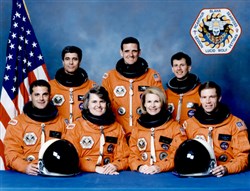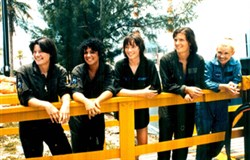VOL. 43 | NO. 30 | Friday, July 26, 2019
A ‘good daddy’ fueled Seddon’s reach for the stars
By Tom Wood

Murfreesboro’s Dr. Rhea Seddon flew a 14-day mission as part of the STS-58 Crew in 1993. Pictured from left are David A. Wolf, Commander John E. Blaha, Shannon W. Lucid, William S. McArthur Jr., mission specialist Seddon, payload specialist Martin Fettman and pilot Richard A. Searfoss.
-- Photograph Courtesy Of NasaRhea Seddon was 21 when man first landed on the moon on July 20, 1969, and she, like so many of us, dreamed that day of being an astronaut.
She made it happen, becoming one of the first six women to be accepted into NASA’s Astronaut Corps.
So did starry-eyed Barry (Butch) Wilmore, just 6-years-old at the time, and who like Seddon was born in Murfreesboro.
Both recalled what it was like for them when the Eagle landed on the moon, when spirits soared and when hearts fluttered as Neil Armstrong and then Edwin (Buzz) Aldrin strolled the lunar surface and planted an American flag on it before returning home.
“I think the whole world was watching, obviously, or an awful lot of them,’’ Seddon says. “And there had been so much buildup to it, even, you know, certainly with the launch of Apollo 11, but all the stuff that went before that.’’
She was home from college at the University of California at Berkley, and spent that day water skiing at Center Hill Lake near Smithville.
“That was sort of part of my childhood growing up, and watching and waiting and hoping that we would fulfill President Kennedy’s goal as he stated in 1961, that we were going to put a man on the moon before the end of the decade.
“So it was a race to get there. It was part of the space race with the Russians, it was just all there as I went along with my life. And it sort of culminated with the moon landing.”
Wilmore, who went to Mt. Juliet High School and then Tennessee Tech, where he played football for both schools, was even more of a product of the space age than Seddon.
“I do remember seeing the black-and-white, kind of noisy images on TV. It wasn’t something that I recall, that I could tell the significance of it at the time though it was very shortly after that as I got a little older that I understood it,” Wilmore says. “But it certainly in many minds – mine included – is one of the most dramatic accomplishments in the history of mankind.

Some of NASA’s first female astronaut candidates take a break from training in Florida in 1978. From left: Sally Ride, Judith Resnik, Anna Fisher, Kathryn Sullivan, Rhea Seddon.
-- Photo Courtesy Of Nasa“I’m glad I’ve got a little bit of memory of it.”
Dream big
Seddon recounted a conversation with her father after watching the Russian satellite Sputnik circle the earth that first put the idea of space flight in her head at age 10.
“I asked him, ‘Do you think people will get to go into space?’ because all of us watched Buck Rogers back then about space adventures, and he said, ‘Yeah, probably people will go into space.’
And I asked him as a 10-year-old might, ‘Do you think I could ever go there?’ And he was a good daddy. He said, ‘yeah, baby, I’ll bet you could.’
“So it was just sort of planted in my mind that that wasn’t so crazy,” Seddon acknowledges. “He didn’t dismiss it. And I thought, ‘well maybe someday I’ll get to go there.’ But it was a totally unrealistic dream, obviously, in the early days of the space program for a little girl.”
She went on to medical school at Tennessee College of Medicine in Memphis and was accepted into residency training in surgery. As a graduation gift, her father paid for flying lessons, and she got her private pilot’s license.
“In the back of my mind, I thought maybe someday they’ll take women into space, and having a background in the sciences and having a pilot’s license might be of some help,” she explains. “It was rather minor and pretty silly to even consider that.
“But then I found out as I was finishing my residency training that (NASA was) for the first time going to open applications to non-pilots and they were going to let women apply. So I thought, ‘Well, if I really want to do this, it probably won’t work out, but I really should take a chance and dream big and apply.”
That was 1977, and a year later she was accepted into the program. She went on to make three Space Shuttle flights (1985 and ’91) and spent a total of 30 days in space.
She was with NASA for 19 years, marrying and starting her family with fellow astronaut Robert (Hoot) Gibson. In 1997, she was named assistant chief medical officer of the Vanderbilt University Medical Group, a position she held for 11 years.
Honors over the years have included being inducted into the Tennessee Aviation Hall of Fame (2005), both the Astronaut Hall of Fame and Tennessee Women’s Hall of Fame in 2015, and the National Football Foundation National Chapter’s Fred Russell Distinguished American Award in 2016.
Wilmore’s journey
After finishing at Tennessee Tech, Wilmore joined the Navy and rose to the rank of captain. He amassed more than 7,000 flight hours with 663 aircraft carrier landings on various Gulf War missions, and graduated from the Naval Test-Pilot School.
That’s about the time he revived his old dreams about entering the astronaut program. He returned to his home state and received his master’s degree in aviation systems at the University of Tennessee Space Institute in Tullahoma, which has produced seven current and former astronauts.
Wilmore was accepted into the program in 2000 and has flown two missions, including a 5½-month stay aboard the International Space Station in 2014-15 for a total of 178 days in space.
“When I got through test-pilot school, you know, completed a couple of master’s degrees, I thought, ‘You know, I’ve got everything that they want, why not try?’” Wilmore says.
“And that’s kind of … ‘you can’t fly any higher and faster than the space shuttle at the time, so why not go for that one?’’’
This is now
These days, Seddon is making speaking engagements and promoting her 2015 self-published book “Go For Orbit,’’ which is available online and at her website. She has also enjoyed attending NASA events related to the 50th anniversary of the moon landing.
“People enjoy (the book). It’s not a great work of literature, but it’s a nice story about a very unique time in the space program,” she points out. “Women became astronauts. When my husband and I married, that was very unusual. We were the first astronauts to marry each other, then I began having children.
“So the book is very dear to me because I was able to tell my story and put it down on paper and let others sort of vicariously enjoy what it might be like to be an astronaut.”
Seddon and Wilmore have gotten to know each other over the years.
“I’ve enjoyed comparing notes with him at some social events, and he has quite a story to tell, as do most astronauts,” Seddon adds.
Wilmore notes Tennessee’s space contributions through the decades, pointing to work done at the national laboratory in Oak Ridge and from state universities.
Also, Vanderbilt’s Aerospace Design Lab team recently won the 2019 NASA Student Launch competition for the fifth time in six years.
A team from the University of Tennessee was one of eight schools to participate in the NASA Mars Ice Challenge.
Former UT football quarterback Joshua Dobbs, now with the Pittsburgh Steelers, was part of an externship at NASA this off-season.
“Certainly, throughout the human space flight program, and there have been a few of us selected to fly these rockets and do these things from the great state of Tennessee. I’m wonderfully proud to be from Tennessee,” says Wilmore, who is training for future missions in Houston, where he lives with his family.
“I grew up and went to county school and to a state college, and it gave me a wonderful education, as good as any in the nation in my opinion.
“And it afforded me the ability to do things I never would have dreamed possible when I was that 6-year-old kid looking at that fuzzy TV screen.
“So I’m grateful to the state and what it’s done for me personally and what it’s done for our nation. So it’s wonderful.”